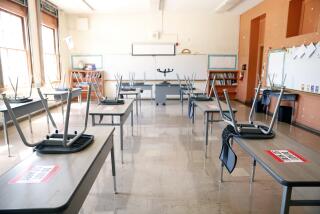TV Review : A Hopeful ‘High School II’ Values Critical Thinking
- Share via
Frederick Wiseman makes films in which patterns and meanings gradually emerge. But a pattern is also emerging in Wiseman’s career, and his latest work, “High School II,” confirms it.
The early Wiseman films, while seemingly removed from their subjects, were considerable social critiques of institutions, from mental hospitals and the welfare system to the meat industry--and public schools, which came off rather badly in Wiseman’s 1968 “High School,” about Philadelphia’s Northeast High.
As Wiseman grows older, he seems to grow more hopeful. His recent “Near Death,” “Central Park” and “Zoo” showed mostly good people doing good work (yes, even in zoos). “High School II” documents success in an East Harlem public school, Central Park East Secondary, where drug use is as rare as dropouts and where 67% of the graduates attend private colleges. The old rules that dominated in the first “High School”--silent classes dominated by a yammering teacher, bureaucratic mini-dictators, few visible parents, rampant boredom--are tossed out in the new “High School.”
The contrast immediately hits you. Students confer with teachers in one-on-one discussions, co-principals Paul Schwartz and Deborah Meier appear to be constantly available for individual meetings with students and their families, and intellectual rigor in a lab-like atmosphere is so dominant that it’s like breathing. Only at the end of the nearly 4-hour film does Meier sum up what we’ve been watching: A pedagogy that blends kindergarten’s sense of active play with the Oxford-Cambridge tradition of a student setting his or her academic course with a tutor.
For a good stretch of “High School II,” all we know is that we’re not in the typical public school anymore. The school’s full name and neighborhood are never mentioned, and its academic program of doctoral-style papers in lieu of standard tests is never articulated. Wiseman’s adherence to a cinema verite that resists factoids doesn’t help him here.
The film, though, cleverly plays on viewer presumptions of both what a public school looks and sounds like, and what a school with predominantly minorities should be. Where are the rigid audiences of students impassively staring at a lecturing teacher? Where are the drugs, the guns, the gangs?
Somewhere, out on the street, but not in here. Here, Central Park East kids sit in small groups, puzzling through engineering or math or literary problems, prodded by friendly but very serious teachers--and deeply concerned parents.
The guiding ethic at Central Park East is what Schwartz and Meier call five “habits of mind”: Show evidence, analyze whose point of view is being expressed, examine alternative solutions, show how ideas are connected to each other and prove their relevancy. But the umbrella value above this school’s “habits” is that endangered species, critical thinking. Wiseman has found it alive and well and living in East Harlem.
* “High School II” airs at 9 tonight on KCET-TV Channel 28 and at noon Saturday on KPBS-TV Channel 15.
More to Read
Only good movies
Get the Indie Focus newsletter, Mark Olsen's weekly guide to the world of cinema.
You may occasionally receive promotional content from the Los Angeles Times.









